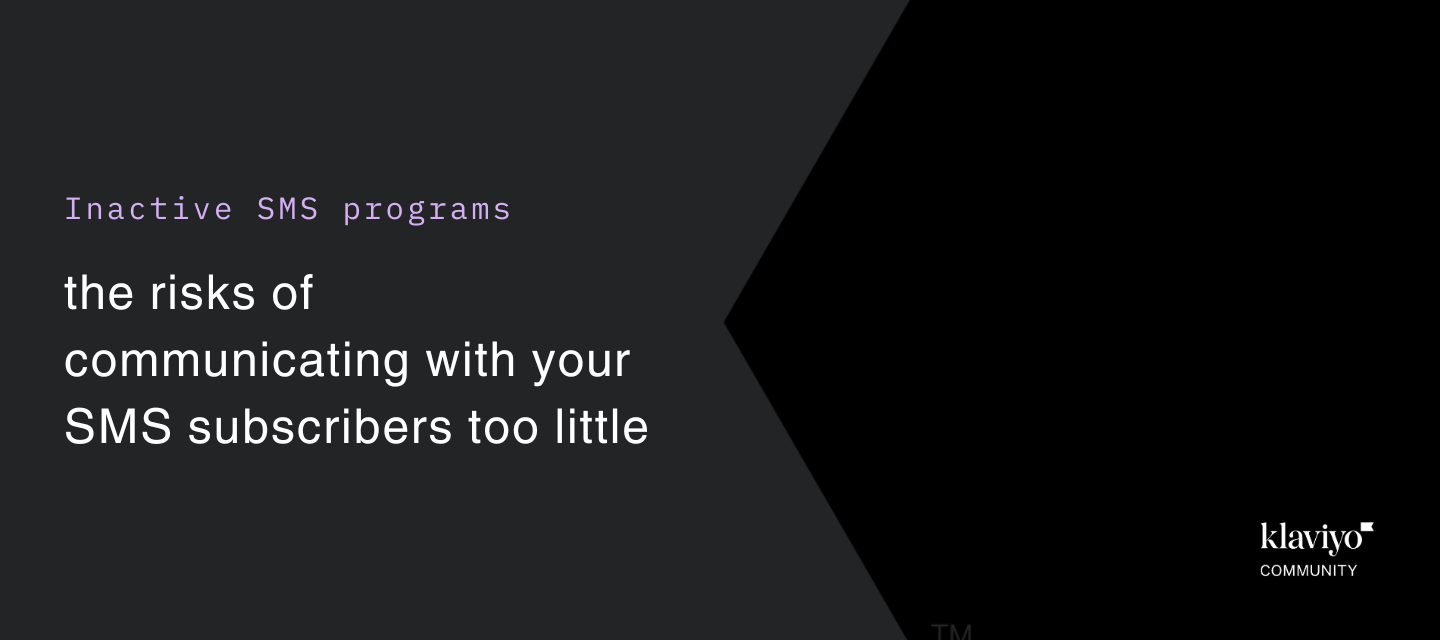When it comes to text message marketing, nearly every service provider and industry professional can agree that messaging your subscribers too frequently is a proven recipe for disaster. Consumers are not likely to stay subscribed to your program for long if your messages start delivering more annoyance than value to their lives. We explore this and other important ideas in the Klaviyo Help Center article Basics: SMS best practices…
However, my goal for this post is to shed some light on the lesser discussed topic of messaging too infrequently! Below are some important things to keep in mind if you are wondering how long you can go without messaging your SMS subscribers:
-
Collecting SMS Subscribers
BEST PRACTICE: New SMS subscribers should receive an opt-in confirmation SMS immediately following their consent.
▪ In the US, the CTIA’s Messaging Principles and Best Practices expects consumers to be “clearly informed” about their enrollment, the SMS program, and how to opt-out. We can assume that consumers will want this information as soon after they opt-in as possible.
▪ In the US, the CTIA’s Short Code Monitoring Handbook explicitly states “The opt-in confirmation message must be delivered immediately after the consumer opts into the program.”
▪ In Canada, the CTA’s Canadian Common Short Code Application Guidelines only outlines an acceptable delay of no more than 30 days between opt-in and the first outgoing SMS for manually entered consent (like in-person forms or consent over the phone). It is understood that consumer initiated opt-ins should result in immediate SMS sent to the number provided. -
Minimum Recommended SMS Frequency
BEST PRACTICE: Every recurring SMS Program should send at least one message per month to every subscriber.
▪ T-Mobile’s Code of Conduct sets the expectation that subscribers be reminded of their ability to opt-out of your SMS program “at least every 5th message or at least once a month for continued consumer awareness, if not on every message.”
▪ For nearly a decade between 2010 and 2020, the Canadian carriers required a monthly text message to be sent to subscribers to remind them that they are subscribed to the SMS program.
▪ Both examples above show that the carriers value consistent and transparent communication with subscribers. -
SMS Culture
BEST PRACTICE: Prioritize relationship-building and customer engagement with SMS as a tool, as opposed to only communicating sporadically when you want to increase sales.
▪ Most people make use of text messaging to stay connected with the closest contacts in their lives. Long periods without communicating with subscribers can leave them questioning the importance of their relationship with your brand.
▪ Text messages are meant to be short, to-the-point, and meaningful. It is easier to provide value and motivate subscribers to engage with your content when you communicate consistently and with a clear purpose. If your subscribers feel connected with your brand’s identity, they will develop brand loyalty - a.k.a. stay as both subscribers AND consumers.
▪ Text messaging culture is fast, which means consumer interest can easily fade away fast too. Consistent communication ensures that consumers remember your brand first when they are in the market for the goods or services you sell. -
The Carriers’ Customers are Your Customers
BEST PRACTICE: Remember that the carriers ultimately determine your deliverability rates, so make them see that their customers are happy being your customers.
▪ Opt-out rates often spike following the first SMS message from a program after a long period of silence. Think of it like an old friend who disappeared without a trace, but then returns all of a sudden - the level of friendship may not be as strong as it was before, especially if it wasn’t that strong to begin with.
▪ Spam is spam, even by any other name. If your SMS program sends too infrequently, it is more likely that the messages your subscribers wanted before are no longer wanted. Unwanted messages are spam, just like unsolicited messages.
▪ The carriers are monitoring what is sent over their networks, so if they see higher-than-average opt-out rates, a general lack of engagement with your messages (low click rates, namely), or unhappy replies to your messages, they can easily filter your messages more heavily or block your messaging entirely.
In summary, only launch an SMS program when you are able/willing to start engaging with your subscribers from the moment they provide their consent. From then on, nurture the relationship by maintaining a consistent cadence of messaging and remember to always add value for your subscribers so they want to keep receiving your messages and purchasing what you sell. The recommendation for most marketing programs is to send between 4 and 6 messages per month, with a minimum of once per month if dropping that low is absolutely necessary.
Wishing you all success with your SMS goals!
*Contributed by Justin Mueller, Klaviyo SMS Operations & Compliance Specialist
🛎 Did I leave anything out? Do you agree or disagree with anything I stated? Do you have a messaging frequency that works particularly well for you (or poorly)?
💬 Keep the conversation going by telling me about it in the comments!





